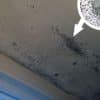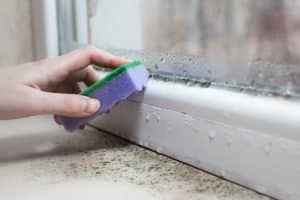Condensation: What it is & how to stop it
What is condensation?
Condensation is defined as water that collects on a cold surface when in contact with humid air, and is something that can be found in many homes and buildings.
Condensation occurs in homes and is not considered to be a building fault, however it is often said to be caused by the building materials used in the building of your home as well as general home usage and living. If condensation is ignored mould will start to form in some areas of your house.

Condensation and how it can be stopped for good
If condensation is not dealt with, it will lead to higher than the recommended (45% – 55%) humidity levels in your home. This will lead to mould growth and damp problems, musky smells. If ignored, it could lead to health problems.
Can condensation occur in modern homes?
Condensation can be found in any types of home; those that are large or small, new or old, terraced or detached.
Modern homes are designed and built in order to preserve as much energy as possible and better insulation, including draught proofed windows and doors to stop heat escaping from your home. However, do not increase ventilation and can allow water vapour to increase risk of condensation.
Where is condensation found?
Condensation is found in a number of places, including:
- Windows and window ledges
- Cold walls
- External doors
- Areas where ceilings and floors come into contact with outside walls
- Poorly ventilated areas
Condensation is found all over the home, in different rooms, due to the range of daily activities that can add to it forming. Tasks involving water can cause condensation to form due to the water in the air turning into droplets and resting around the house; this can be seen after bathing, cooking, washing and drying clothes and boiling kettles. In some cases up to 17 litres of water can be produced daily in a family home.
How can condensation be reduced?
Simple changes to the home can reduce the amount of condensation found; for example, putting lids on saucepans to reduce the steam and drying clothes outdoors.
Additionally, opening windows and doors and installing adequate extraction fans will also help as they work to remove extra moisture found in the air. Of Course these are just temporary methods, and will require constant attention for reducing condensation and keeping humidity levels at optimal levels.
Condensation is a problem that is found in many homes up and down the country, regardless of age, size or location. Luckily, there are many things that can be done to prevent condensation, such as small changes in daily household activities. By keeping doors to bathroom and kitchen closed while moisture is being produced. Ensuring that correct extractor fans are working efficiently.
Most condensation problems start in the bathroom and kitchen as they are the rooms where most water vapour is produced. Solving it there will prevent it in other parts of your house.
Changes in daily activities to prevent condensation
- Drying clothes outside
- Using an efficient extractor fan in your kitchen and bathroom (Ensure that is operates long enough)
- If no extraction fan is available in the bathroom, open the windows slightly, but not the door after bathing!
- Closing kitchen doors when cooking (Also, opening window if there is no extractor fan)
- Avoid using paraffin heaters and fuel less gas heaters as they are heavy producers of moisture
Temporary solutions
Permanent solutions suggestions (Ventilation Fans)
Important to know about an extractor fan
- Maintenance – Make sure you regularly clean the extractor fans and clean/change the filters. You should do this every 1-2 months. If you have’t done this for a while, do it now.
- Get a humidity controlled or timer fan – Most standard fans are set to turn off as soon as you turn off the light in the bathroom or kitchen. As you can imagine, this will have no effect on extracting moisture if this happens. If you have a standard fan, make sure it is on long enough to do its job.Having a fan with humidity control, will make sure the fan is extracting any excess moisture automatically to normal conditions (45%-55%) before it turns off. These fans will have a sensor and a adjuster for the humidity percentage.A timer fan is also a good way to extract humidity, they usually operate for a set amount of minutes, and will help extract excess moisture. Depending on your needs, set the timer accordingly to allow enough time for the moisture to be extracted.
What to do next?
Because every home is different, the extractor fan or a ventilation system requirements will be different too. You can call us on 0208 8463 9696 and speak to our team of experts now, who will help you choose the product that is right for you. Alternatively you can fill in our contact form, and we will get back to you ASAP.
- Call us now: 0208 8463 9696
- Fill in our Contact Form
- Or email us [email protected] with your question
- Browse our range of Extractor Fans





























Add comment
You must be logged in to post a comment.